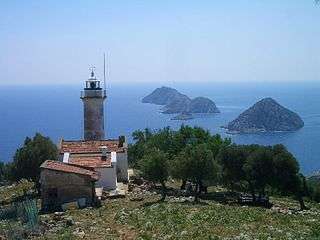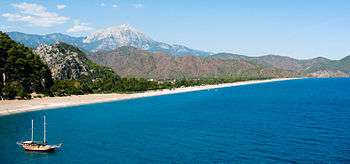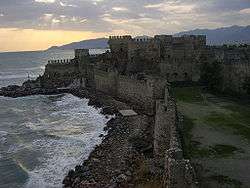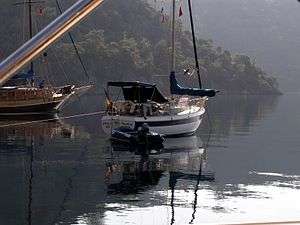Mediterranean Turkey
Mediterranean Turkey (Akdeniz Bölgesi) is a region in Turkey. It occupies entire southern coast of Turkey and some places more inland.

Regions
| Cilician Mountains mostly rural part wth beautiful verdant mountain scenery dotted by ancient citadels, all just a stone throw away from hundreds of kilometres of almost totally deserted beaches |
| Cilician Plains |
| Hatay the southeastern part of the region which extends towards Syria, and annexed to Turkey in 1939, almost two decades after the Republic was found, and therefore still maintains its Mideast-influenced culture and great cuisine |
| Lakes District |
| Lycia rugged and heavily wooded, with many turquoise coves heavily indendating towards the land; this is the "blue voyage" country backed by impressive Lycian ruins and stunning landscapes |
| Pamphylia mainly a mass tourism destination, this is the shining gem of the Turkish Riviera with some of the clearest waters and longest sandy beaches along the Mediterranean; there are more than a few things to catch the glimpse of history lovers, too |
Cities
- 🌍 Antalya — the largest city in southwestern Turkey and the unquestioned capital of the Turkish Riviera
- 🌍 Adana — one of the biggest cities in the country, a riverside city with some industry
- 🌍 Alanya — town east of Antalya with some history to see and beaches to swim
- 🌍 Antakya (also known as Antioch) — great food and history near the Syrian border; the home of Mosaic Museum with a rich Roman collection
- 🌍 Fethiye — nestled on the tip of a gulf perfect for yachting, this town and its vicinity offers sports like paragliding or hiking (the Lycian Way)
- 🌍 Kaş — an unspoiled resort town with traditional architecture in the southwest of the region
- 🌍 Marmaris — a nice town, albeit touristy, and the gateway for "Blue Voyage"
- 🌍 Mersin — a large city with some huge palm trees on the coastal promenade
- 🌍 Taşucu — a pleasant town with cobbled streets and frequent ferries to Northern Cyprus
Other destinations
- 🌍 Anemurium — ruins of a Roman city on the southernmost point of Turkey
- Butterfly Valley — an isolated canyon with waterfalls and a large colony of butterflies
- 🌍 Heaven and Hell — a geological curiosity, two large chasms next to each other located 4 km inland from sea shore
- 🌍 Kayaköy — ghost town with plenty of hiking opportunities in the surrounding area
- 🌍 Kemer - A resort town 45km south of Antalya. Olympos Teleferik is close to Kemer
- 🌍 — waterfalls near Antalya
- 🌍 Ölüdeniz — the "Blue Lagoon", picture of which is perhaps the most used image on travel brochures about Turkey
- 🌍 Olympos — backpacker destination with tree-houses in the forest near a pebble beach and Roman ruins, also featuring a rich nightlife
- 🌍 Xanthos and Letoon — ruins of the capital city of ancient Lycia, a UNESCO World Heritage Site
Understand

Mediterranean coast of Turkey is mostly a narrow strip of land squeezed in between pine-covered Taurus Mountains (Toros) and the Mediterranean Sea. Having been spared from pollution thanks to the lack of heavy industry, lying under one of the sunniest skies of Europe, together with its rich art and history, make the region the top tourism destination in the country.
History
Home to a number of ancient civilizations, namely Lycia, Pamphylia, and Cilicia west to east, Mediterranean Turkey was captured by the Romans about a century before the birth of Christ. After a brief occupation by the Crusaders on their way to Jerusalem, as evidenced by a number of Crusader-built or -expanded citadels mainly on the eastern sections of the region, and a number of Crusader-backed Armenian kingdoms, Turkic Seljuqs seized the region. It was during this era when the ancestors of most of the region's locals poured in from Central Asia as nomadic tribes. Some still keep the tradition, wintering on the warm coast and heading for heights of Taurus Mountains or plateaus of Central Anatolia more inland to the north when summer approaches with their goat and camel caravans. Seljuqs were replaced by Ottomans in the 1400s.
Climate
As expected, Mediterranean Turkey enjoys the typical Mediterranean climate: the temperature can go above 40°C in rainless—and even cloudless—summers, while the rest of the year is quite rainy, although winter lows rarely go below +5°C and snowfall is virtually unknown in the region (except the tops of the quite high mountains close to the coastal strip, of course). The season with the highest amount of rainfall is winter (more or less limited to late October through early April in this region) and can be accompanied by strong winds, to the point of storms, in the localities close to the shore, especially around Antalya.
Water temperature of the Mediterranean Sea is around 28°C during summer, i.e. May through October.
Inland Lakes District has an altogether different continental climate than the rest of the region, and the winters can be severe and quite snowy there.
Talk
The region is home to a plethora of Turkish dialects, from Muğla şivesi, some of which is totally incomprehensible for non-local Turks spoken in Lycia to the dialect of Cilician Mountains, which is essentially a mainland "extension" of Cypriot Turkish. Syrian dialect of Arabic is also prevalent around Antakya.
However, thanks to heavy tourism, English will likely be enough to communicate during your trip, especially in the western parts of the region (i.e. Pamphylia and Lycia) and especially if you don't intend to go off the beaten path. German, Russian, and Scandinavian languages may also be helpful, especially when you visit one of the resort towns mainly frequented by those nations.
Get in
- By plane — major airports in the region open for international flights are located in Dalaman, Antalya, and Adana.
- By train — Adana has daily direct passenger train services from both Istanbul and Ankara (and a number of other cities on the way, such as Konya), while Isparta and Burdur has services from Izmir. There is also a once-weekly connection between Mersin, and Adana and Aleppo in Syria.
- By bus — All cities and a good number of towns, especially those with touristical importance, have direct bus connections from all big cities of the country.
- By car — The region is connected to the northern parts of the country by a number of highways, though passes that the roads have to go through when running over Taurus Mountains mean that the roads may have more windings and be narrower than usual motorways. However, O-21 north of Adana/Mersin, is an exception as it is a wide motorway with separated directions.
- By boat — There are ferries from Northern Cyprus to a number of coastal towns. See also Ferries in the Mediterranean.
Get around
By public transport
Buses (for long-haul routes such as Antalya to Adana) and minibuses (for shorter routes between a major city and nearby towns) will be your main mode of transportation within the region. Services are fairly frequent and quite comfortable, and especially so in more touristed areas of Lycia and Pamphylia.
Train service in the region is limited to Cilician Plains with a branch line south to Iskenderun in Hatay. Lakes District also has a (mostly unused) line stretching out to northwest.
There is no long-haul ferry route along the coast, however, boat trips offer pleasant cruises into remoter parts of the coastline from major touristy towns.
There are no flights between the region's airports.
By car
The highway D400, which closely follows the shoreline of Turkish Mediterranean from one end to another, is the main road of the region. While most of it is very wide (at least 2 lanes per direction) and in a very good condition, some sections are very winding and narrow such as the section between Alanya and Silifke. There are other roads, such as D650, which connects more inland regions (Lakes District) with the D400, thus the coastline.
See

- Ruins — The region is dotted by many ancient city ruins. Most date back to indigenous civilizations of the region, which were expanded or rebuilt by Romans later.
- Citadels — Being on the strategic main route between Europe and the Middle East, there are also lots of citadels in the region, either surrounding the cities or in a valley or on a rocky hill to defend the nearby roads from unwanted guests. Many, especially those in the eastern portions of the region, are either built by Crusaders from scratch or heavily fortified.
Itineraries
- Lycian Way — A 509-km, waymarked hiking trail connecting Fethiye with the southern suburbs of Antalya.
Do

- Yachting. One of the top cruising areas in the Mediterranean basin, southwestern reaches of Mediterranean Turkey (coasts of Lycia and western Pamphylia) offers abundant yachting options. In the much famed and hardly overestimated Blue Cruise (a.k.a. Blue Voyage; Mavi Yolculuk), started by a group of Turkish intellectuals in 1940s and usually compared to cruising in Caribbean, you take a chartered gulet type yacht (two-masted wooden boats) for a pre-specified amount of time (usually 15 days), and cruise from cove to cove with turquoise waters surrounded by pine-covered mountains suddenly rising at the edge of the sea, calling at coastal towns and fishing villages on the way. Marmaris, Fethiye, Kaş, and Bodrum and Kuşadası (the last two of which are in Aegean Region) are usual starting points of a Blue Cruise, although voyages extending all the way from Izmir to Antalya are not unheard of.
Eat
While local cuisine traditionally embraces goat meat, which is less common to the much of the rest of the country and may lead to stomach trouble to who are unaccustomed to it, restaurants in touristy towns frequently feature more familiar treats. Fish restaurants abound in seaside towns, while typical Turkish fast food döner and the like is common in bigger towns and cities. Adana in the east is known for its own style of kebabs (Adana kebabı), while cuisine of Antakya to southeast, being culturally a part of neighbouring Syria, features highly delicious and partially vegetarian (or even vegan)-friendly Middle Eastern fare.
Drink
A great way to reduce your bottled water costs in this hot region is to use free cold water dispensers, locally called sebil (pronounced say-beel), which can usually be found on the sides of the streets and mosque courtyards in less-touristed towns and neighbourhoods in the region. They look like small, white refrigators and usually have two faucets: red one delivers warm (or mildly hot depending on the weather) water, while the blue one offers comfortably cold water. Though the water coming out of the faucets is not from a commercially-bottled jar, and likely from the city water network, it's harmless and causes no stomach upsets. A way to reduce the risk may be allowing yourself a week after arrival in the region to get accustomed to local microflora and -fauna that may be present in the water and then taking full advantage of sebils.
Stay safe
Mediterranean Turkey lies on a more southern latitude than anywhere else in Europe except Cyprus and the Greek island of Crete, so take it easy in the beginning of your trip and pay close attention to early signs of heat stroke and dehydration. While on the beach, applying liberal amounts of sun lotion wouldn't hurt.
If you plan to spend time in the mountains, be wary of scorpions. They thrive in Mediterranean climate and rocky areas are their habitats, so never reach under a rock without carefully checking first. Keeping your backpack closed at all times will keep them out, and don't forget to check the inside of your shoes first, should you take them out for any amount of time.
On crowded public beaches (i.e., those that aren't owned and enclosed by a resort hotel), don't leave your valuables like cell phones and cameras unattended, or better yet, don't take them to the beach. While many beaches are patrolled by the police and security cameras, there are still reports of petty theft.
Otherwise, Mediterranean towns are very safe (and security forces very keen to keep them so), although there may be rough areas in large cities such as Antalya, Mersin, and Adana.
Go next
- Aegean Region to the north/northwest has a lot in common with Mediterranean Turkey (especially the climate, landscape, and flora), yet has unique aspects that make it a separate region.
- Northern Cyprus is a short ferry hop away to the south.
- Most travellers intending to get deep into Middle East to the southeast of region cross to Syria from one of the border gates around Antakya.
- If the Seljuq sites in Alanya and Antalya aroused your interest, head north to Central Anatolia for a lot more.
- Southeastern Anatolia to east is quite an off the beaten path destination and is an altogether different world.